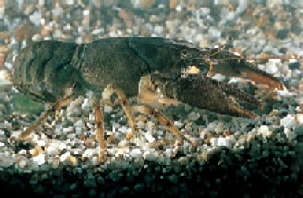

Biodiversity
Action
Plan
Marking Progress
- Rate of spread of Signal Crayfish upstream towards Gunthwaite Dam area slowed
- Populations of White-clawed Crayfish maintained
- Ponds used as ‘ark’ sites for White-clawed Crayfish
Maintaining and possibly increasing White-clawed Crayfish populations in the Barnsley area will be difficult but actions include:
What is being done:
- Annual surveys of tributaries to the river Dearne to the west of Barnsley.
- Daking Brook scheduled as a Local Wildlife site but not under positive conservation management for White-clawed Crayfish.
- Translocation, under licence, of White-clawed Crayfish to small isolated ‘ark’ pond at Cannon Hall. However population not sustained.
White-clawed Crayfish Action Plan
Key Objectives
- Raise awareness of the threat to our native crayfish from the crayfish plague and the invasive species, good practice when fishing, and the legal restrictions and protection for crayfish.
- Carry out annual monitoring surveys for the presence of White-clawed Crayfish, and the invasive Signal Crayfish, in relevant water bodies.
- Undertake positive conservation management of site(s) that support White-clawed Crayfish [see good conservation practice].
- Provide ‘offline’ refuges (‘arks’) to help safeguard the White-clawed Crayfish species.
- Ensure any sites (including ‘ark sites’) are given protection through designation or other means.
Proposed actions
- Publicity to promote good practice when accessing water bodies eg for fishing, and on the legal restrictions for crayfish.
- Promote good management and avoidance of pollution incidents near known White-clawed Crayfish site(s)
- Continue annual monitoring surveys for White-clawed Crayfish, and invasive Signal Crayfish, in relevant water bodies.
- Promote conservation management of Daking Brook LWS sites supporting White-clawed Crayfish
- Establish one or more ‘ark’ ponds for White-clawed Crayfish in Daking Brook catchment
Roles:
Riparian land owners, particularly in the Daking Brook catchment
- follow best practice in reducing or stopping the expansion of Signal Crayfish
- follow best practice in managing site(s) to support and increase any existing White-clawed Crayfish populations
Barnsley Council as planning authority:
- take into consideration records of White-clawed Crayfish presence in the planning process
- set conditions in relevant planning applications to ensure that relevant habitat features for White-clawed Crayfish are maintained and enhanced.
Voluntary groups and volunteers:
(subject to required licensing)
- provide records of White-clawed Crayfish
- help with information about condition of sites supporting White-clawed Crayfish
- help with measures to support White-clawed Crayfish, eg: habitat management.
White-clawed Crayfish
